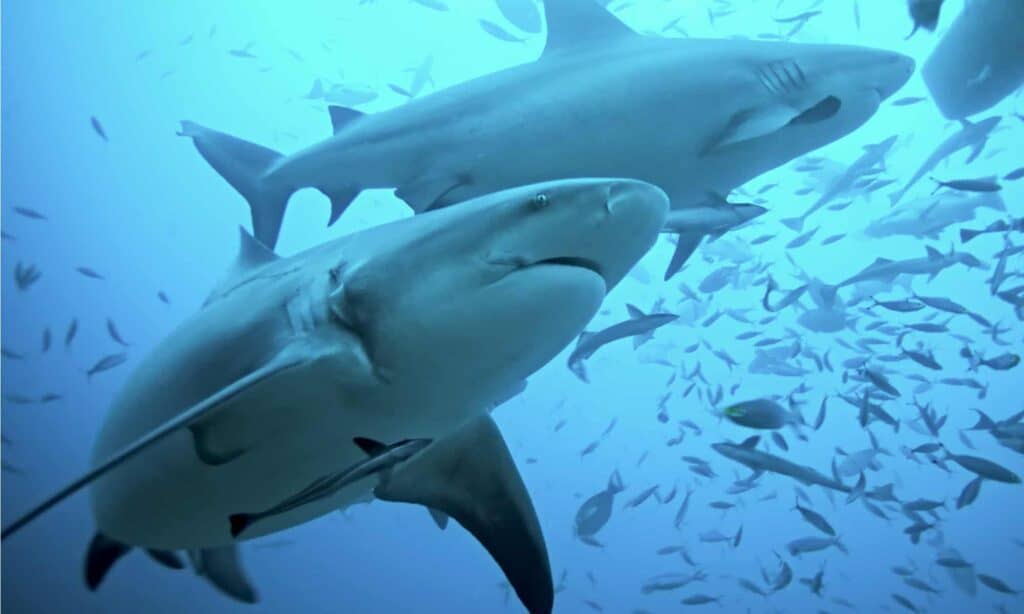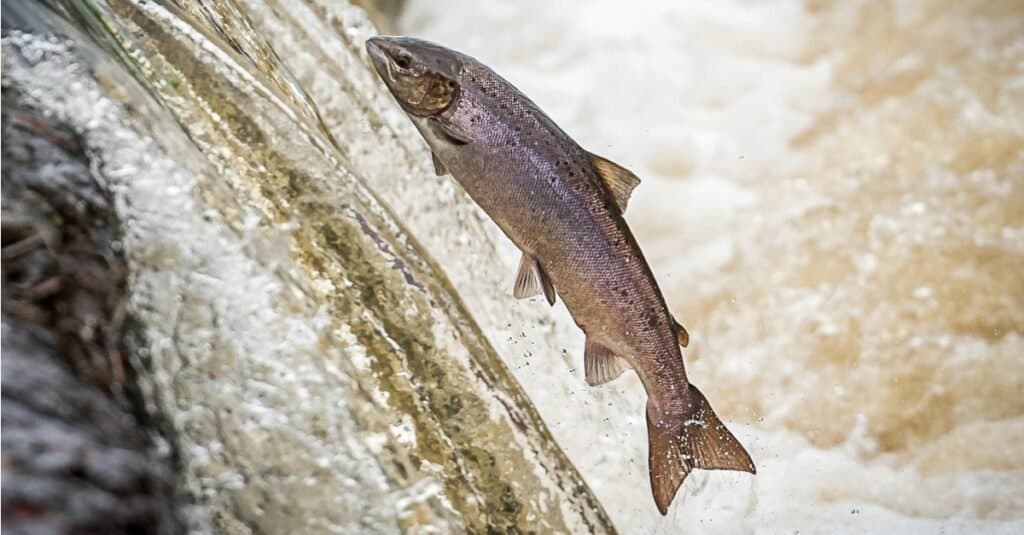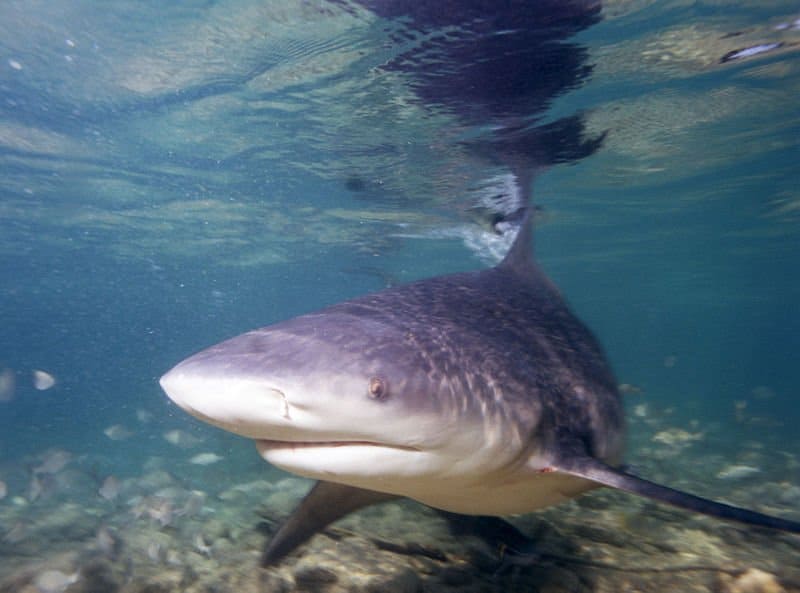Discovering that bull sharks can travel up river rapids like salmon is a little jarring considering their size. They’re between 7 to 11 feet long and weigh up to 500 lbs. Where are people discovering these sharks jumping rapids?
Bull sharks are famous for their ability to survive in both freshwater and saltwater environments. Only 5% of all shark species can survive in freshwater, and most can’t do it for a sustainable amount of time.
The bull shark is an exception and spends up to 4 years in freshwater. In the Amazon River, bull sharks come 2,500 miles inland. They’ve also been spotted in the Mississippi River. They prefer warm and shallow environments, including coastlines, estuaries, lagoons, and rivers.
Are there bull sharks in Lake Nicaragua? Do fish travel up rapids? We’ll go over these questions and some other interesting facts about fish that leap from the water.
What is a Bull Shark?

Bull sharks live in both freshwater and saltwater.
©Martin Prochazkacz/Shutterstock.com
Bull sharks are aggressive sharks. They’re territorial, and their hunting strategy involves ramming their prey with their blunt noses before taking a bite. They’ll repeat this process until their target succumbs.
These sharks tend to live in murky places where it’s hard to see, so they rely on their excellent sense of smell to find their food. Their primary diet is made of fish, which includes rays and other sharks. Small dolphins, turtles, crabs, shrimp, starfish, and sea urchins are also on the menu.
When a bull shark is in freshwater, its anatomy is what saves it from the demise that its solely saltwater cousins experience. Usually, a shark’s body takes in the freshwater from the environment to try and balance the salt in the body, and this causes the shark to explode.
Bull sharks can pee much faster than most sharks, and they’ll urinate up to 20 times more while in freshwater to flush water out of the body. Their liver regulates the saltiness of that pee depending on the surrounding environment. This keeps them from exploding.
Do Salmon Travel Up River Rapids?

Salmon climb up river rapids.
©iStock.com/PerfectStills
Yes, salmon travel up river rapids. They return to the place where they hatched to spawn the next generation. Baby salmon need environments that aren’t murky and contain a lot of dissolved oxygen which makes river systems perfect.
No one is quite sure how salmon know how to return from the ocean to their birthplace. They’re so determined to find the specific location that they’ll jump river rapids to do it. They will also jump through waterfalls if they can muster it.
Dams get in the way of salmon migrations, but most dams have a fish ladder that allows the salmon to jump up to the level of the reservoir.
What Bull Shark Climbs River Rapids?
A special bull shark called the Lake Nicaragua shark travels up the river rapids of the San Juan River. This gives them a route between the lake and the Caribbean Sea. It’s believed it only takes up to 11 days for these sharks to make this journey.
Lake Nicaragua is a freshwater lake in Southern Nicaragua on the San Juan River, and it’s the only freshwater lake that hosts marine life. Species associated with saltwater have taken up residence in the lake.
Old beliefs dictate that these bull sharks are endemic to Lake Nicaragua, but studies done in the 60s debunked this. These sharks travel up to eight rapids to get to Lake Nicaragua.
Bull sharks are concentrated on the oceanic coast and river mouth of the San Juan River. Only a small population of bull sharks make the journey up to the lake. They’re driven by the need to raise their pups which they birth naturally and nurture for a time. The environment that the lake provides is much more appealing than an oceanic environment.
How Do Lake Nicaragua Sharks Climb a River Rapid?

Bull sharks point their bodies in the direction they want to go and take the biggest first swish of the tail that their body can do.
©Albert Kok, CC BY-SA 3.0, via Wikimedia Commons – License
The river rapids that are encountered on the San Juan River are navigable by large boats, so the type of rapids that the Nicaragua sharks jump isn’t quite as impressive as salmon.
Fish that jump rapids, like the Lake Nicaragua shark, point their bodies in the direction they want to go and take the biggest first swish of the tail that their body can do. They continue beating their tails as fast as they can until they’re in the air. Their bodies are torpedo-shaped which allows them to cut through and out of the water with little resistance.
What’s amazing about this stunt is that an animal so large can propel itself so far out of the water. It’s hard to imagine an 11-foot shark suddenly leaping through the surface of the water to jump over an obstacle.
Are There Other Cool Animals in Lake Nicaragua?
The largest source of freshwater in Nicaragua is Lake Nicaragua. It’s an especially important spot ecologically because it plays host to many endemic species like cichlids and tilapia.
There are sawfish that also travel from the ocean into Lake Nicaragua. They do this when it’s time to reproduce just like bull sharks. Tarpons are another marine animal found in the lake.
It’s believed the lake used to be a bay, but that some geological activity sealed it off from the sea. This explains why marine life is found in a lake that is cut off from the ocean except for the most adventurous travelers willing to traverse the San Juan River.
Are Bull Sharks and Salmon Flying Fish?

Bull sharks and salmon are not flying fish.
©Agami Photo Agency/Shutterstock.com
No, bull sharks and salmon are not flying fish. Flying fish are one of the fastest fish in the ocean. Unlike salmon and bull sharks, flying fish do not tolerate freshwater.
Flying fish are smaller fish with wing-shaped fins that allow them to glide over 600 feet in the air once they’ve left the water. They’re between a half foot and two feet in size and weigh about two pounds. They have a torpedo-shaped body, just like salmon and bull sharks, which aids them when they’re ready to launch themselves into the air.
The photo featured at the top of this post is © wildestanimal/Shutterstock.com
Thank you for reading! Have some feedback for us? Contact the AZ Animals editorial team.






